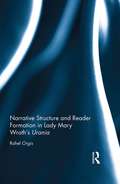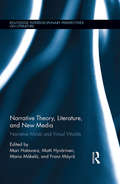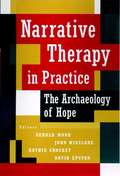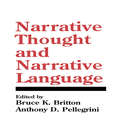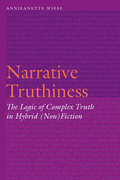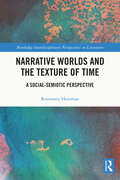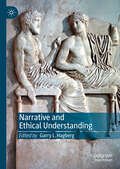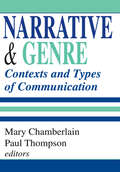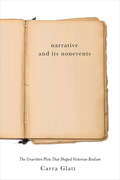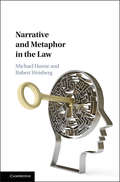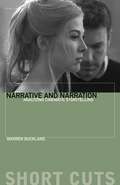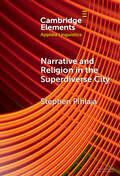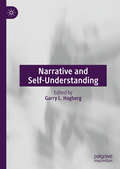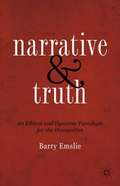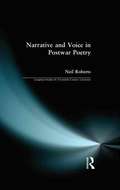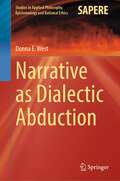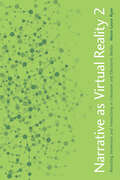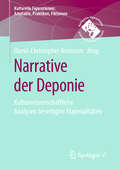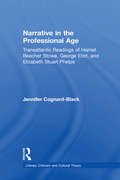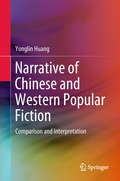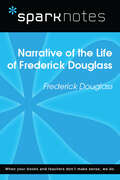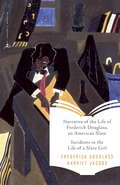- Table View
- List View
Narrative Structure and Reader Formation in Lady Mary Wroth's Urania
by Rahel OrgisNarrative Structure and Reader Formation in Lady Mary Wroth’s Urania offers the first systematic formal and thematic analysis of Wroth’s Urania in its historical context and explores the structural means by which Wroth fashions her readership. The book thus has a dual focus, at once on narrative art and reader formation. It makes two original claims, the first being that the Urania is not the unorganized accumulation of stories critics have tended to present it as, but a work of sophisticated narrative structures i.e. a complex text in a positive sense. These structures are revealed by means of a circumspect narratological analysis of the formal and thematic patterns that organise the Urania. Such an analysis furthers our understanding of the reading strategies that Wroth encourages. The second claim is, then, that through the careful structuring of her text Wroth seeks to create her own ideal readership. More precisely, the formal and thematic structures of the Urania engage with readers’ expectations, inviting them to reflect on prominent thematic issues and respond to the text as what early modern prefaces term "good" readers. Combining narratological methods with a generic perspective and taking into account the work of book historians on early modern reading practices, this monograph provides a new approach to the Urania, supplementing the typically gender- or (auto)biographically-oriented interpretations of the romance. Moreover, it contributes to the study of early modern (prose) narrative and romance and exemplifies how historically contextualised narratological analysis may yield new insights and profit research on reading strategies.
Narrative Theory
by Kent PuckettKent Puckett's Narrative Theory: A Critical Introduction provides an account of a methodology increasingly central to literary studies, film studies, history, psychology and beyond. In addition to introducing readers to some of the field's major figures and their ideas, Puckett situates critical and philosophical approaches towards narrative within a longer intellectual history. The book reveals one of narrative theory's founding claims - that narratives need to be understood in terms of a formal relation between story and discourse, between what they narrate and how they narrate it - both as a necessary methodological distinction and as a problem characteristic of modern thought. Puckett thus shows that narrative theory is not only a powerful descriptive system but also a complex and sometimes ironic form of critique. Narrative Theory offers readers an introduction to the field's key figures, methods and ideas, and it also reveals that field as unexpectedly central to the history of ideas.
Narrative Theory, Literature, and New Media: Narrative Minds and Virtual Worlds (Routledge Interdisciplinary Perspectives on Literature)
by Mari Hatavara Matti Hyvärinen Maria Mäkelä Frans MäyräOffering an interdisciplinary approach to narrative, this book investigates storyworlds and minds in narratives across media, from literature to digital games and reality TV, from online sadomasochism to oral history databases, and from horror to hallucinations. It addresses two core questions of contemporary narrative theory, inspired by recent cognitive-scientific developments: what kind of a construction is a storyworld, and what kind of mental functioning can be embedded in it? Minds and worlds become essential facets of making sense and interpreting narratives as the book asks how story-internal minds relate to the mind external to the storyworld, that is, the mind processing the story. With essays from social scientists, literary scholars, linguists, and scholars from interactive media studies answering these topical questions, the collection brings diverse disciplines into dialogue, providing new openings for genuinely transdisciplinary narrative theory. The wide-ranging selection of materials analyzed in the book promotes knowledge on the latest forms of cultural and social meaning-making through narrative, necessary for navigating the contemporary, mediatized cultural landscape. The combination of theoretical reflection and empirical analysis makes this book an invaluable resource for scholars and advanced students in fields including literary studies, social sciences, art, media, and communication.
Narrative Therapy in Practice: The Archaeology of Hope
by Gerald Monk Kathie Crocket David Epston John WinsladeHow to apply the definitive postmodern therapeutic technique in a variety of situations, including treating alcoholics, counseling students, treating male sexual abuse survivors, and more. Written with scholarship, energy, practicality, and awareness.
Narrative Thought and Narrative Language (Cog Studies Grp of the Inst for Behavioral Research at UGA)
by Bruce K. Britton A. D. PellegriniSince before the dawn of history, people have been telling stories to each other and to themselves. Thus stories are at the root of human experience. This volume describes empirical investigations by Jerome Bruner, Wallace Chafe, David Olson, and others on the relationship between stories and cognition. Using philosophical, linguistic, anthropological, and psychological perspectives on narrative, the contributors provide a definitive, highly diversified portrait of human cognition.
Narrative Traditions in International Politics: Representing Turkey (The Palgrave Macmillan Series in International Political Communication)
by Johanna VuorelmaThis book introduces the concept of narrative tradition to study representation in international politics. Focusing specifically on the case of Turkey, the book shows how narrative traditions are constructed, maintained, and passed on by a loose epistemic community that involves practitioners and experts including scholars, journalists, diplomats, and political representatives. Employing an interpretative approach, the book distinguishes between four narrative traditions in the study of Turkey: Turkey as a state that is (1) getting lost, (2) standing at a decisive crossroad, (3) led by strongmen, and (4) struggling with a creeping Islamisation.These narrative traditions carry enduring beliefs that not only describe, moralise, judge, and stigmatise Turkey, but also contribute to the idea of the West. The book focuses on knowledge that is produced from a Western perspective, showing that Turkey provides a channel through which the Western self can be debated, challenged, celebrated, and judged.
Narrative Truthiness: The Logic of Complex Truth in Hybrid (Non)Fiction (Frontiers of Narrative)
by Annjeanette WieseNarrative Truthiness explores the complex nature of truth by adapting Stephen Colbert&’s concept of truthiness (which on its own repudiates complexity) into something nuanced and positive, what Annjeanette Wiese calls &“narrative truthiness.&” Narrative truthiness holds on to the importance of facts while complicating them by looking at different types of truth, as well as the complexity, contradictions, and consequences of truth in the context of human experience. Wiese uses narrative theory to analyze several examples of hybrid (non)fiction: works that refuse to exist as either fiction or nonfiction alone and that challenge monolithic definitions of truth. She examines memoirs by Lauren Slater, Michael Ondaatje, Binjamin Wilkomirski, Tim O&’Brien; fiction by Julian Barnes, Richard Powers, W. G. Sebald; Onion headlines; comics and graphic memoirs by Joe Sacco, Art Spiegelman, and David Small; and fake news.Narrative Truthiness foregrounds the complexity that is inherent in human understanding and experience and in the process demonstrates the significance of the complex tensions between what we feel to be true and what is true, and how we are shaped by both.
Narrative Worlds and the Texture of Time: A Social-Semiotic Perspective (Routledge Interdisciplinary Perspectives on Literature)
by Rosemary HuismanThis book brings together a model of time and a model of language to generate a new model of narrative, where different stories with different temporalities and non-chronological modes of sequence can tell of different worlds of human – and non-human – experience, woven together (the ‘texture of time’) in the one narrative. The work of Gerald Edelman on consciousness, J.T. Fraser on time, and M.A.K. Halliday on language is introduced; the categories of systemic functional linguistics are used for detailed analysis of English narrative texts from different literary periods. A summary chapter gives an overview of previous narrative studies and theories, with extensive references. Chapters on ‘temporalization’ and ‘spatialization’ of language contrast the importance of time in narrative texts with the effect of ‘grammatical metaphor’, as described by M.A.K. Halliday, for scientific discourse. Chapters on prose fiction, poetry and the texts of digital culture chart changes in the ‘texture of time’ with changes in the social context: ‘narrative as social semiotic’.
Narrative Worlds and the Texture of Time: A Social-Semiotic Perspective (Routledge Interdisciplinary Perspectives on Literature)
by Rosemary HuismanThis book brings together a model of time and a model of language to generate a new model of narrative, where different stories with different temporalities and non-chronological modes of sequence can tell of different worlds of human – and non-human – experience, woven together (the ‘texture of time’) in the one narrative. The work of Gerald Edelman on consciousness, J.T. Fraser on time, and M.A.K. Halliday on language is introduced; the categories of systemic functional linguistics are used for detailed analysis of English narrative texts from different literary periods. A summary chapter gives an overview of previous narrative studies and theories, with extensive references. Chapters on ‘temporalization’ and ‘spatialization’ of language contrast the importance of time in narrative texts with the effect of ‘grammatical metaphor’, as described by M.A.K. Halliday, for scientific discourse. Chapters on prose fiction, poetry and the texts of digital culture chart changes in the ‘texture of time’ with changes in the social context: ‘narrative as social semiotic’.
Narrative and Ethical Understanding
by Garry L. HagbergThere has been a steady stream of articles written on the relations between ethics and the interpretation of literature, but there remains a need for a book that both introduces and significantly contributes to the field – particularly one that shows how we can think more openly and creatively about the multiform powers of ethical narrative by considering ethically significant literature. This volume offers an analytically acute and culturally rich way of understanding how it is that we can productively think philosophically about the narrative structures that describe our ethical lives and what kind of distinctive conceptual, and in some cases personal, progress we can make by doing so. Given the extremely widespread interest in ethical issues, this volume will strike resonant chords far and wide on arrival, while offering something new in bringing together the study of long-form narrative, the language of moral psychology, and detailed literary case studies. Given the vast expansion of narrative studies in recent years, the time for just such a volume is right.
Narrative and Genre: Contexts and Types of Communication (Routledge Studies In Memory And Narrative Ser. #Vol. 1)
by Paul Thompson Mary ChamberlainAny life story, whether a written autobiography or an oral testimony, is shaped not only by the reworkings of experience through memory and re-evaluation, but also by art. Any communication has to use shared conventions not only of language itself, but also the more complex expectations of ""genre,"" the forms expected within a given context and type of communication. This collection of essays by international academics draws on a wide range of disciplines in the social sciences and the humanities to examine how far the expectations and forms of genre shape different kinds of autobiography and influence what messages they can convey. After investigating the problem of genre definition, and tracing the evolution of genre as a concept, contributors explore such issues as: How far can we argue that what people narrate in their autobiographical stories is selected and shaped by the repertoire of genre available to them? To what extent is oral autobiography shaped by its social and cultural context? What is the relationship between autobiographical sources and the ethnographer? Narrative and Genre presents exciting new debates in an emerging field and will encourage international and interdisciplinary discussion. Its authors and contributors are scholars from the fields of anthropology, cultural studies, literary analysis, psychology, psychoanalysis, social history, and sociology.
Narrative and Its Nonevents: The Unwritten Plots That Shaped Victorian Realism (Victorian Literature and Culture Series)
by Carra GlattThis book is about what does not happen in the Victorian novel. The description may sound absurd, yet consideration of alternatives to a given state of affairs is crucial to our understanding of a novel. Plot emerges out of the gradual elimination of possibilities, from the revelation, on the first page of a work, that we are in nineteenth-century London and not sixteenth-century Paris, to the final disclosure that Pip returns home too late to marry Biddy but is now free to pursue his lost love Estella.Through careful examination of the plots of such classics as Charles Dickens’s Great Expectations, Charlotte Brontë’s Villette, Wilkie Collins’s The Moonstone, Jane Austen’s Pride and Prejudice, Henry James’s The Ambassadors, Elizabeth Gaskell’s Mary Barton, and others, Glatt argues for the central role of these "unwritten plots" in Victorian narrative construction. Abandoning the allegorical mode—in which characters are bound by fixed identities to reach a predetermined conclusion—and turning away from classical and historical plots with outcomes already known to audiences, the realist novel of the Victorian era was designed to simulate the openness and uncertainty of ordinary human experience. We are invested in these stories of David Copperfield or Elizabeth Bennet or Lucy Snowe in part because we cannot be entirely sure how those stories will end. As Glatt demonstrates, the Victorian novel is characterized by a proliferation of possibilities.
Narrative and Metaphor in the Law
by Robert Weisberg Michael HanneIt has long been recognized that court trials, both criminal and civil, in the common law system, operate around pairs of competing narratives told by opposing advocates. In recent years, however, it has increasingly been argued that narrative flows in many directions and through every form of legal theory and practice. Interest in the part played by metaphor in the law, including metaphors for the law, and for many standard concepts in legal practice, has also been strong, though research under the metaphor banner has been much more fragmentary. In this book, for the first time, a distinguished group of legal scholars, collaborating with specialists from cognitive theory, journalism, rhetoric, social psychology, criminology, and legal activism, explore how narrative and metaphor are both vital to the legal process. Together, they examine topics including concepts of law, legal persuasion, human rights law, gender in the law, innovations in legal thinking, legal activism, creative work around the law, and public debate around crime and punishment.
Narrative and Narration: Analyzing Cinematic Storytelling (Short Cuts)
by Warren BucklandFrom mainstream blockbusters to art house cinema, narrative and narration are the driving forces that organize a film. Yet attempts to explain these forces are often mired in notoriously complex terminology and dense theory. Warren Buckland provides a clear and accessible introduction that explains how narrative and narration work using straightforward language.Narrative and Narration distills the basic components of cinematic storytelling into a set of core concepts: narrative structure, processes of narration, and narrative agents. The book opens with a discussion of the emergence of narrative and narration in early cinema and proceeds to illustrate key ideas through numerous case studies. Each chapter guides readers through different methods that they can use to analyze cinematic storytelling. Buckland also discusses how departures from traditional modes, such as feminist narratives, art cinema, and unreliable narrators, can complicate and corroborate the book’s understanding of narrative and narration. Examples include mainstream films, both classic and contemporary; art house films of every stripe; and two relatively new styles of cinematic storytelling: the puzzle film and those driven by a narrative logic derived from video games. Narrative and Narration is a concise introduction that provides readers with fundamental tools to understand cinematic storytelling.
Narrative and Religion in the Superdiverse City (Elements in Applied Linguistics)
by Stephen PihlajaThis Element focuses on how narrative is used to construct religious identity in superdiverse contexts, considering specifically how people talk about their own religious identity, and the religious identity of others. Drawing on interviews with twenty-five participants, and numerous site visits throughout the city of Birmingham (UK), the analysis focuses on how self and other positioning is used to construct religious identity in talk about beliefs, actions, and behaviours in different contexts. Additionally, the analysis shows how conflict emerges and is resolved in spaces where people of different faiths and no faith interact, and how people talk about and understand community. Finally, a model for talking about faith in diverse contexts is presented to help people find common goals and act together towards shared interests.
Narrative and Self-Understanding
by Garry L. HagbergThis exciting new edited collection bridges the gap between narrative and self-understanding. The problem of self-knowledge is of universal interest; the nature or character of its achievement has been one continuing thread in our philosophical tradition for millennia. Likewise the nature of storytelling, the assembly of individual parts of a potential story into a coherent narrative structure, has been central to the study of literature. But how do we gain knowledge from an artform that is by definition fictional, by definition not a matter of ascertained fact, as this applies to the understanding of our lives? When we see ourselves in the mimetic mirror of literature, what we see may not just be a matter of identifying with a single protagonist, but also a matter of recognizing long-form structures, long-arc narrative shapes that give a place to – and thus make sense of – the individual bits of experience that we place into those structures. But of course at precisely this juncture a question arises: do we make that sense, or do we discover it? The twelve chapters brought together here lucidly and steadily reveal how the matters at hand are far more intricate and interesting than any such dichotomy could accommodate. This is a book that investigates the ways in which life and literature speak to each other.
Narrative and Truth
by Barry EmslieIn this book, Emslie establishes that narrative explanations are to be preferred over non-narrative in the humanities. They are more truthful in two senses. They both correspond more closely to reality and allow inference as to normative values. This is particularly the case when aesthetics are added to the mix.
Narrative and Voice in Postwar Poetry (Longman Studies In Twentieth Century Literature)
by Neil RobertsPoetry in English since the Second World War has produced a number of highly original narrative works, as diverse as Derek Walcott's Omeros, Ted Hughes' Gaudete and Anne Stevenson's Correspondences. At the same time, poetry in general has been permeated by narrative features, particularly those linguistic characteristics that Mikhail Bakhtin considered peculiar to the novel, and which he termed "dialogic". This book examines the narrative and dialogic elements in the work of a range of poets from Britain, America, Ireland, Australia and the Caribbean, including poetry from the immediate postwar years to the contemporary, and novel-like narratives to personal lyrics. Its unifying theme is the way in which these poets, with such contrasting styles and from such varied backgrounds, respond to and creatively adapt the language-worlds, and hence the social worlds in which they live. The volume includes a detailed bibliography to assist students in further study, and will be a valuable resource to undergraduate and postgraduate students of contemporary poetry.
Narrative as Dialectic Abduction (Studies in Applied Philosophy, Epistemology and Rational Ethics #64)
by Donna E. WestThis book presents a fresh approach to the communicability of narratives, revealing the cognitive underpinnings of Charles Sanders Peirce’s pragmatistic model. It demonstrates how abductive processes modify habits of belief and action in what Peirce refers to as double consciousness. Abductions generated during double consciousness paradigms have increased efficacy compared to instinctual abductions. Novel inferences from working memory become consciously integrated with existing long-term memory units which permits fuller consideration of the plausibility of propositions. Special attention is given to children’s prelinguistic means to represent propositional or assertory conflicts, and to resolve these conflicts via listening and re-telling narrators’ accounts. Overall, this book serves both a theoretical and applied purpose. It is intended to support innovative therapeutic interventions to facilitate the (re)construction of narratives by adults and children. Its practical applications and theoretical grounding will appeal to graduate students and scholars alike, who wish to examine narrative as an interdisciplinary enterprise—an ontological and cultural phenomenon (narration by way of action/image sequences), not just a literary/linguistic paradigm. Ultimately, this account presents narrative as a modal forum to resolve logical and practical conflicts, compelling the interpreter to become an involved partner in the narrated event itself.
Narrative as Virtual Reality 2: Revisiting Immersion and Interactivity in Literature and Electronic Media
by Marie-Laure RyanRethinking textuality, mimesis, and the cognitive processing of texts in light of new modes of artistic world construction.Winner of the Aldo and Jeanne Scaglione Prize for Comparative Literary Studies from the Modern Language Association of AmericaIs there a significant difference between engagement with a game and engagement with a movie or novel? Can interactivity contribute to immersion, or is there a trade-off between the immersive "world" aspect of texts and their interactive "game" dimension? As Marie-Laure Ryan demonstrates in Narrative as Virtual Reality 2, the questions raised by the new interactive technologies have their precursors and echoes in pre-electronic literary and artistic traditions. Approaching the idea of virtual reality as a metaphor for total art, Ryan applies the concepts of immersion and interactivity to develop a phenomenology of narrative experience that encompasses reading, watching, and playing. The book weighs traditional literary narratives against the new textual genres made possible by the electronic revolution of the past thirty years, including hypertext, electronic poetry, interactive drama, digital installation art, computer games, and multi-user online worlds like Second Life and World of Warcraft.In this completely revised edition, Ryan reflects on the developments that have taken place over the past fifteen years in terms of both theory and practice and focuses on the increase of narrativity in video games and its corresponding loss in experimental digital literature. Following the cognitive approaches that have rehabilitated immersion as the product of fundamental processes of world-construction and mental simulation, she details the many forms that interactivity has taken—or hopes to take—in digital texts, from determining the presentation of signs to affecting the level of story.
Narrative der Deponie: Kulturwissenschaftliche Analysen beseitigter Materialitäten (Kulturelle Figurationen: Artefakte, Praktiken, Fiktionen)
by David-Christopher AssmannDie Deponie ist eine paradoxe, risikobehaftete Einrichtung. Die moderne Gesellschaft erhofft sich durch sie, weggeworfene, unbrauchbare oder gefährliche Dinge, Stoffe oder Substanzen ein für alle Mal sich selbst überlassen zu können. Zugleich erfordern die entsprechenden Ablagerungsstellen erhebliche Aufmerksamkeit und technischen Aufwand. Auch wenn die Deponie ihre Legitimation aus der Annahme zieht, den auf ihr angesammelten Müll zu domestizieren, ist sie trotz aller Versicherungen und Vorkehrungen nämlich eines gerade nicht: abgeschlossen. Die Beiträge dieses Bandes nehmen diese Beobachtung zum Ausgangspunkt. Sie fragen nach den ökologisch problematischen und ästhetisch produktiven Implikationen der Anhäufung beseitigter Materialitäten und deren Verknüpfungen mit literarisch-kulturellen Diskursen. In exemplarischen Probebohrungen eröffnen sie Perspektiven einer literatur-, medien- und kulturwissenschaftlichen Untersuchung der Deponie. Zwei bisher eher getrennt voneinander operierende akademische Wissensbereiche werden dazu zusammengebracht: Studien auf dem Gebiet des Ecocriticism mit solchen der kulturwissenschaftlichen Analyse von Praktiken und Poetiken des Sammelns und Archivierens. Die Deponie wird so sichtbar als ein dynamisch-agentielles Konglomerat aus sozialen Praktiken, Diskursen und Materialitäten, mit denen Narrative u.a. aus Literatur, Fotografie, Film und Computerspielen verwoben sind.
Narrative in the Professional Age: Transatlantic Readings of Harriet Beecher Stowe, Elizabeth Stuart Phelps, and George Eliot (Literary Criticism And Cultural Theory Ser.)
by Jennifer Cognard-BlackChallenging previous studies that claim anxiety and antagonism between transatlantic Victorian authors, Jennifer Cognard-Black uncovers a model of reciprocal influence among three of the most popular women writers of the era. Combining analyses of personal correspondence and print culture with close readings of key narratives, this study presents a
Narrative of Chinese and Western Popular Fiction: Comparison And Interpretation
by Yonglin HuangThis book presents a comprehensive and systematic study of the narrative history and narrative methods of Chinese and Western popular fiction from the perspectives of narratology, comparative literature, and art and literature studies by adopting the methodology of parallel comparison. The book is a pioneering work that systematically investigates the similarities and differences between Chinese and Western popular fiction, and traces the root causes leading to the differences. By means of narrative comparison, it explores the conceptual and spiritual correlations and differences between Chinese and Western popular fiction and, by relating them to the root causes of cultural spirit, allows us to gain an insight into the cultural heritage of different nations. The book is structured in line with a cause-and-effect logical sequence and moves from the macroscopic to the microscopic, from history to reality, and from theory to practice. The integration of macro-level theoretical studies and micro-level case studies is both novel and effective. This book was awarded Second Prize at the Sixth Outstanding Achievement Awards in Scientific Research for Chinese Institutions of Higher Learning (Humanities & Social Sciences, 2013).
Narrative of the Life of Frederick Douglass (SparkNotes Literature Guide Series)
by SparkNotesNarrative of the Life of Frederick Douglass (SparkNotes Literature Guide) by Frederick Douglass Making the reading experience fun! Created by Harvard students for students everywhere, SparkNotes is a new breed of study guide: smarter, better, faster. Geared to what today's students need to know, SparkNotes provides: *Chapter-by-chapter analysis *Explanations of key themes, motifs, and symbols *A review quiz and essay topicsLively and accessible, these guides are perfect for late-night studying and writing papers
Narrative of the Life of Frederick Douglass, an American Slave & Incidents in the Life of a Slave Girl
by Frederick Douglass Harriet JacobsThis Modern Library Paperback Classics edition combines the two most important African American slave narratives into one volume. <P><P>Frederick Douglass's Narrative, first published in 1845, is an enlightening and incendiary text. Born into slavery, Douglass became the preeminent spokesman for his people during his life; his narrative is an unparalleled account of the dehumanizing effects of slavery and Douglass's own triumph over it. <P><P>Like Douglass, Harriet Jacobs was born into slavery, and in 1861 she published Incidents in the Life of a Slave Girl, now recognized as the most comprehensive antebellum slave narrative written by a woman. Jacobs's account broke the silence on the exploitation of African American female slaves, and it remains crucial reading. <P><P>These narratives illuminate and inform each other. This edition includes an incisive Introduction by Kwame Anthony Appiah and extensive annotations.
